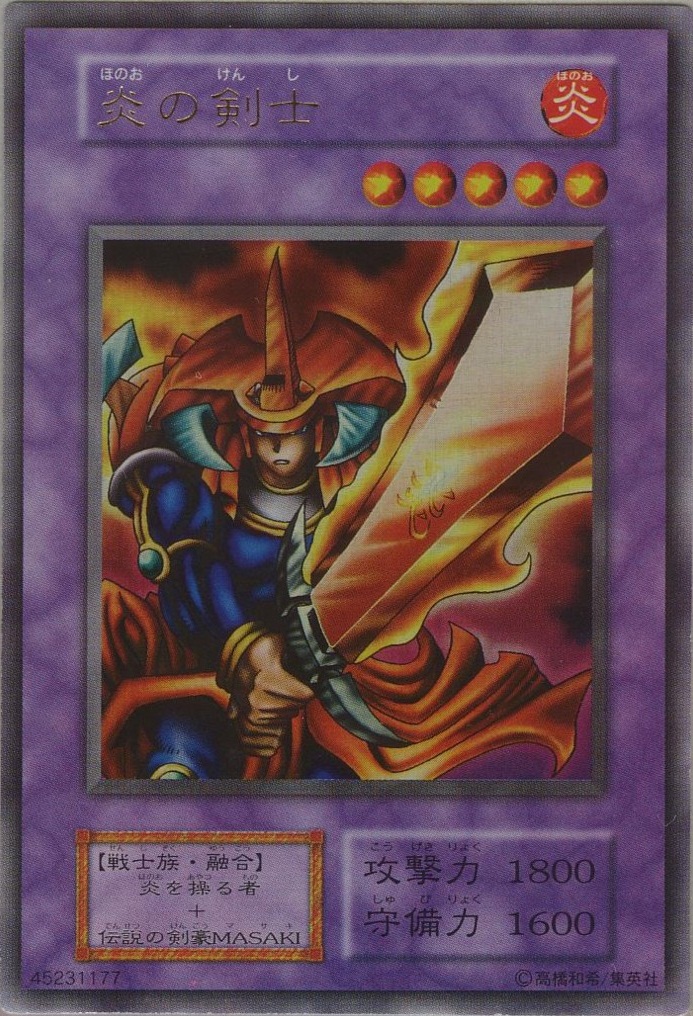OCG Official Rules (Starter Box)
(This is the 2nd of 3 part of the Starter Box. This is also Part 2 of the OCG Official Rules.)
The Starter Box was the first major product released by Konami to have a major impact on the game post Vol.1. The above video was released something around March detailing the rules of the game at the time. For those who watched it, they knew how the Official Card Game would be played.
FUSION
For those of you unfamiliar with how early Yu-Gi-Oh! was, FUSIONS [

By using Fusion (TCG: Polymerization), you are able to Summon this kind of monster onto the field:
Notice the violet hue of the card compared to the yellow color of the normal monsters. This would become one of the ways the Yu-Gi-Oh! card game distinguishes the different kinds of monsters. The other difference is in the lore box.
Unlike regular monsters, there is no lore for Fusion Monsters. Instead, it declares Tribe, that it is a Fusion Monster (

In the OCG Official Rules, they are required to be on the field before you could activate Polymerization to perform the Fusion Summon. This meant the act of Fusing takes at least two turns to perform. This, combined with the inferiority of the monsters used to Fusion Summon, meant that Fusion Summoning was unviable in the competitive scene for most of Series 1. Konami attempted to rectify this, but that story is further down the line.
Anyway, Fusion Monsters were placed into their own Deck called the FUSION DECK (
FIELD CARDS
Later known as Field Magic Cards (フィールド
Unlike its brethren, Field Cards have a different label 「
Which Field Card increases what Tribe?
Mountain (
Forest (
Wasteland (
Sogen (
Umi (
Yami (
Furthermore, Umi and Yami were the first cards to decrease the Attack and Defense Power of monsters through the second sentence of their effects.
They decreased the following Tribes ATK/DEF by 200:
Umi - Fire and Machine
Yami - Angel
Like Fusion, Field Cards weren't seriously used, for the most part. There is a possible exception, but that's for later.
THE DIFFERENCE BETWEEN TRAPS
Trap Cards weren't ignored in the changes. When Trap Hole was introduced in Vol.1, a part of its effect read:
「
This can be translated as "Destroy 'Pitfall' and that monster." In Series 1, the majority of Trap Cards destroyed (
Dragon Capture Jar ( Doragonzoku Fūin no Tsubo "Dragon-Tribe Seal Jar") was the first Continuous Trap Card (
THE FIELD (UPDATED)
モ - Monster Card Zone
魔 - Magic & Trap Zone
デ - Deck Zone
墓 - Graveyard
フ- Field Card Zone - Where a Field Card can be activated
融 - Fusion Deck Zone - Where the Fusion Deck is placed
With the Starter Box, the full field was now available for use. Now how did Duels start?
Duel Start
Before a Duel begins, players may bet a card from their Deck/Star Chips. The loser of the Duel then gives that card to their opponent. This was known as the ANTE RULE. Once this was done, then the real steps began (Credit goes to Dan of YGOrg for getting the Starter Box rulebook. You can read his discoveries here. The following is take verbatim with my own thoughts on the subject).
1. First make sure to greet your opponent, say a greeting to them and shake their hand. (Simple good sportsmanship. The Ante Rule could be invoked by both players at this stage.)
2. Each player shuffles their Deck thoroughly, then hands their Deck to their opponent to have their opponent also shuffle their Deck thoroughly. This is called a cut. After the cutting is finished, place your own Deck on your own Duel Field in the Deck placement location. In addition, separate your Fusion Deck from your normal Deck and place it on the Fusion Deck placement location on your Duel Field. (Doing this is meant to reduce the likelihood of the opponent manipulating where their cards will be in the Deck.)
3. Show to your opponent that your Side Deck contains exactly 10 cards. At this time you can do so with the cards face-down. If during Duel 2 or 3 your Side Deck number has gone down, make sure you show the current number of cards to your opponent. (Having 10 cards in the Side Deck is mandatory in Series 1 Duels. While this was likely waived in Casual settings, this would be enforced during official play).
4. Play a game of rock-paper-scissors to determine who goes first. (What we still do to this day.)
If the Ante Rule is invoked, the top card of the Deck will be drawn and placed away from the field. The winner can take it after the Duel. Once this is done, draw the top five cards from your Deck and begin.
CONCLUSION
The Starter Box was something of a seismic shift compared to what had come before. New rules and mechanics saw introduction to the game as the Official Rules were officially instated, installing more of the foundation of the Yu-Gi-Oh! card game. Fusions, Field Cards and Continuous Traps were now playable in the game as well as how to start and play the game.
So what was the result? That will be discussed in the next article.
It's time to talk about the Starter Box proper.








Comments
Post a Comment